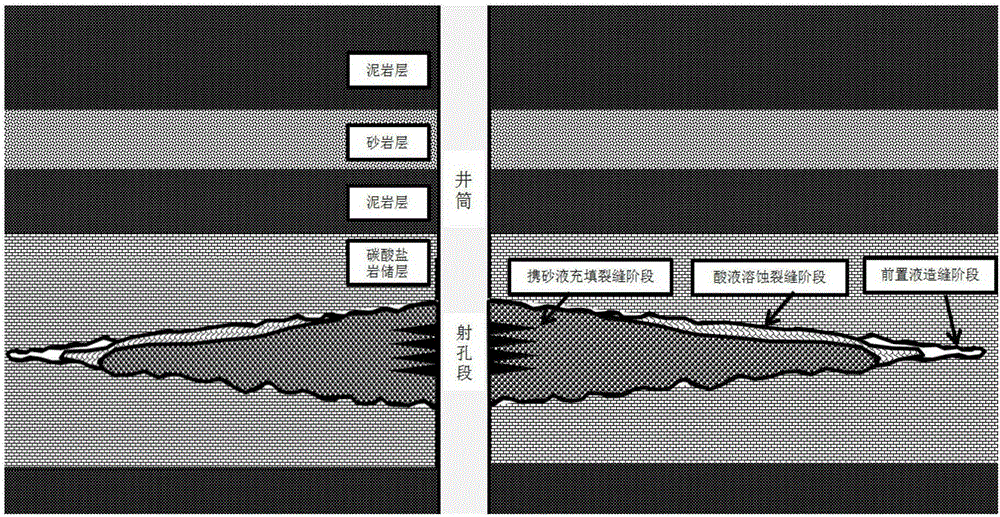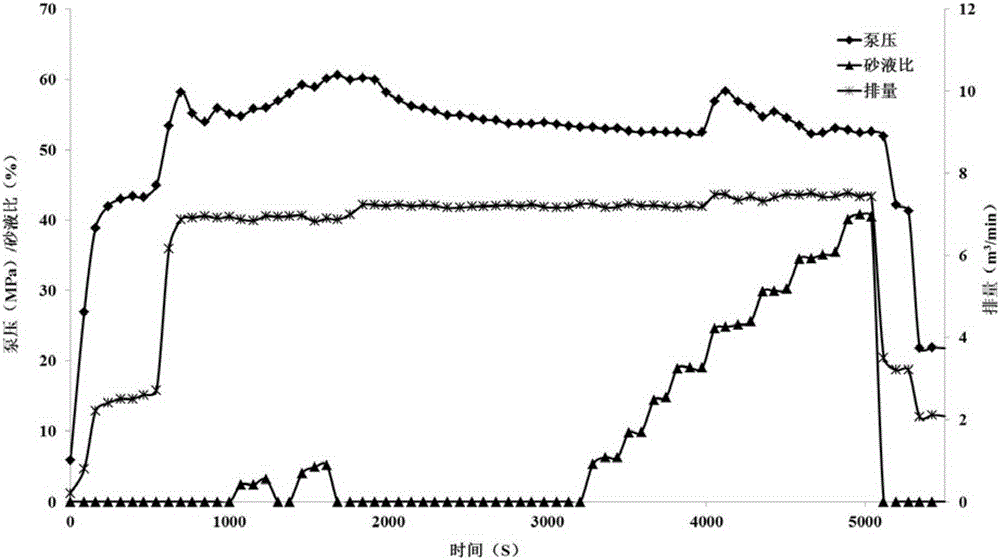However, the rock modulus of
carbonate rock reservoirs is usually high, the
fracture pressure is high, and the construction during the sanding stage is difficult. At the same time, the construction fluid does not react with the carbonate rock, and it is difficult to communicate with the micro-fracture
system inside the reservoir, resulting in sanding. After fracturing, the
gas supply volume is limited, making it difficult to sustain high and stable production
In order to combine acid fracturing and sand fracturing technology, cross-linked acid-carrying sand acid fracturing technology has emerged at home and abroad, that is, cross-linking acid
system is used to carry sand acid fracturing, but the cross-linking acid is usually cross-linked on the ground, and the acid solution after cross-linking The
frictional resistance of the jelly is much greater than that of the
fracturing fluid jelly, which makes the construction pressure higher. At the same time, the cross-linked acid is a macromolecular
polymer, and it is difficult to break the gel after cross-linking, which seriously damages the reservoir
[0004] U.S. Patent US531003 discloses an acid fracturing method for controlling the height of upper and lower fractures by injecting two kinds of low-density and high-density acid liquid systems. The low-density acid
liquid system is injected into the upper oil and gas reservoir around the
wellbore to extend the fractures upward. Injecting a high-density acid
liquid system into the lower oil and gas reservoirs in the lower oil and gas reservoirs to extend the fractures downward, but this method is a single acid fracturing process, and rock
creep after acid fracturing can easily lead to a decrease in
fracture conductivity [0005]
Chinese patent CN101353958 discloses a temperature-controlled variable-
viscosity acid fracturing method for oil and gas wells. The temperature change from the
wellhead to the bottom of the well is used to control the
gradual increase in the viscosity of the acid fluid. This method can effectively reduce the
wellbore friction and at the same time the acid fluid enters the high-temperature formation After the viscosity increases, the acid-rock
reaction rate decreases, but this method still uses a single acid fracturing process to transform the reservoir, and the rock softens and creeps during the acid fracturing process, and it is difficult to form a fracture
system with
high conductivity [0006]
Chinese patent CN103089228 discloses a cross-linked acid-carrying sand acid fracturing method for argillaceous
dolomite on the ground. It mainly uses cross-linking acid-carrying sand to fill cracks for the reduction of
fracture conductivity after acid fracturing of argillaceous
dolomite. The
liquid system is ground cross-linked acid, which has high
wellbore friction and high construction pressure. At the same time, the cross-linked acid system is difficult to achieve high sand ratio construction (average sand ratio 11.2%), resulting in too low sand concentration and poor conductivity of acid-etched fractures. insufficient
[0007]
Chinese patent CN103590803 discloses a
solid acid-acid fracturing process. Firstly, a non-reactive liquid is used to create fractures, and then water-insoluble
solid acid at
room temperature is injected, so that the
solid acid enters artificial or natural fractures and is gradually released through the action of formation
temperature and pressure. The acid solution is used to etch the deep part of the formation. The
solid acid particles injected in this method can continuously release the acid solution to dissolve the rock formation, but the solid particles themselves do not have the function of supporting fractures. At the same time, this method also adopts a single acid fracturing process. Reservoir, it is difficult to form a fracture system with
high conductivity [0008] Non-
patent literature "Application of Cross-linked
Acid Fracturing and Sanding Technology in Well Shi 31" (Oil and Gas Well Testing, 2007, Volume 16, Supplement), "Application of Cross-linking Acid and Sanding Acidizing Fracturing Technology in Complex
Lithology Reservoirs "(Acta
Petroleum Sinica, 2008, Volume 29), "Practice of Crosslinked
Acid Fracturing Technology for
Dolomite Reservoirs in Jingbian Gas Field" (Oil and Gas Geology and
Recovery, 2008, Volume 15) and "
Carbonate Rock Reservoir cross-linked acid-carrying sand acid fracturing new technology" (China Science and Technology Papers Online, 2010, Volume 5) all introduced the acid fracturing and sanding design of cross-linking acid-carrying sand after the previous cross-linking acid fracture creation method, but the cross-linking acid used in the above method is all ground cross-linking acid, the friction of the wellbore is relatively high, and the pressure of acid fracturing operation is high. Insufficient flow conductivity of cracks
In addition, the acid fracturing methods introduced in the literature all use cross-linked acid to create fractures. The acid fracturing
reaction speed is too fast, the acid fluid loss is large, and the length of acid-etched fractures is limited, making it difficult to form deep acid fracturing.
[0009] Non-
patent literature "Cooperative Operation Technology and Advantages of Acidizing and Sanding Fracturing" (
Petroleum Drilling Technology, 2009, Volume 37) and "Research and Application of Acidic and Sanding Fracturing Combined Restructuring Technology" (Xinjiang
Petroleum Science and Technology, 2012 In 2010, Vol. 22), a pre-acid-sand fracturing method was introduced. Before sand fracturing, a period of gelling acid system was injected, followed by a period of spacer fluid, and then pre-fluid and sand-carrying fluid were injected. , the acid fracturing-sanding
composite process adopts pre-acid fracture formation, the acid rock
reaction speed is too fast, and it is easy to produce a certain
diameter expansion around the wellbore, which increases the acid fluid
loss rate and makes it difficult to achieve deep stimulation
At the same time, after the
fracturing fluid enters the acid-dissolved and enlarged fractures in the later stage, the
filtration loss will increase, and the difficulty of adding sand will increase.
[0010] At present, for the stimulation of carbonate rock reservoirs, especially tight low-permeability, high-pressure carbonate rock reservoirs, there is still a lack of a method that can not only achieve high conductivity of fractures but also carry out deep acid fracturing stimulation.
 Login to View More
Login to View More  Login to View More
Login to View More 

